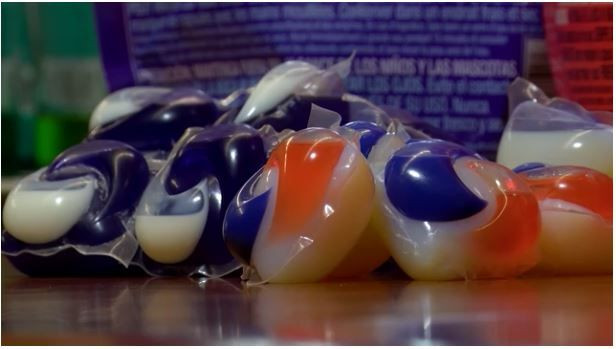Laundry Detergent 'Pods' May Risk Children's Health; Experts Warn Against Dangerous Chemicals

It seems innocent enough, but certain types of laundry detergent may be put children's health at risk. New research published in Pediatrics found that detergent, particularly laundry pods, is more dangerous for kids than other types of laundry and dishwasher detergent.
Researchers sifted through more than 62,000 calls made to poison control centers in the U.S. from January 2013 through December 2014; each was related to laundry and dishwasher detergent exposure in children aged 6 and younger. They found that 60 percent of all the calls were made regarding children's exposure to detergent pods, small gel packets containing a single load of highly concentrated detergent. Of those calls, nearly half of them were referred to a health care facility for evaluation and treatment, which was significantly more than calls related to exposures to traditional laundry detergent (17 percent), traditional dishwasher detergent (4 percent), or dishwasher detergent pods (5 percent).
What’s more, serious health effects, such as coma, trouble breathing, heart problems, and death, were only seen in young children. This suggests laundry pods are a special threat to children, possibly increasing their risk of a serious medical outcome like hospitalization.
"Many families don't realize how toxic these highly concentrated laundry detergent packets are," Dr. Marcel J. Casavant, a co-author of the study, said in a statement. "Use traditional laundry detergent when you have young kids in your home. It isn't worth the risk when there is a safer and effective alternative available."
Unfortunately, incidents related to laundry pods only seem to be growing. The study showed that incidents related to laundry pods, as opposed to its traditional counterparts, were implicated in the majority of calls made to poison control. Respective centers received more than 30 calls a day about children who had been exposed to a laundry pod, which is about one call every 45 minutes.
The study is consistent with previous reports that have linked laundry pods to adverse health outcomes. A 2014 study found that between 2012 and 2013, there was 17,230 reports of children aged 6 and younger who had swallowed or inhaled the pods. For example, between January and June 2015, more than 6,000 calls were made to poison control centers nationwide about incidents involving young children swallowing or inhaling laundry pods, or getting its contents in their eyes, according to the American Association of Poison Control Centers (AAPCC). In 2015, Consumer Reports made the decision to exclude laundry pods from their list of recommended laundry detergents due to these risks.
To curb incidents related to laundry pod exposure, ASTM International, a standards organization that develops and publishes voluntary consensus technical standards for various products, published a voluntary Standard Safety Specification for Liquid Laundry Packets in 2015. Promising, but the specifications focus on labeling recommendations and several characteristics that the packaging and liquid laundry pod should utilize. For this reason, some experts don't believe the report is effective or substantial enough to reduce unintentional exposures to the contents of laundry detergent packets.
"This voluntary standard is a good first step, but it needs to be strengthened," Dr. Gary Smith, senior author of the study, said in a statement. "Unless this unacceptably high number of exposures declines dramatically, manufacturers need to continue to find ways to make this product and its' packaging safer for children."
However, experts recommend that families use traditional detergent instead of laundry packets
Experts recommend that families with children younger than age 6 use traditional detergent instead of packets because they are “much less toxic.” If they can’t give up laundry pods, they recommend that the packages or containers be closed and put away, out of children’s reach, immediately after use.
Source: Casavant M, et al. Pediatrics. 2016.
Published by Medicaldaily.com



























